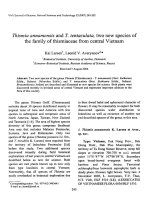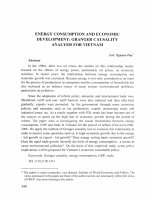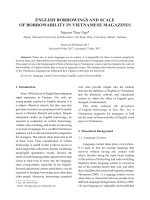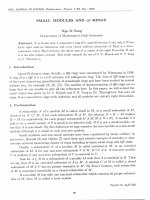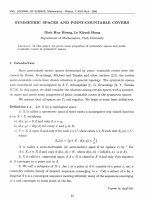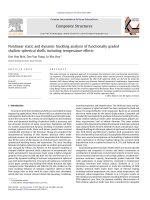DSpace at VNU: U Pb and Sm Nd dating on ophiolitic rocks of the Song Ma suture zone (northern Vietnam): Evidence for upper paleozoic paleotethyan lithospheric remnants
Bạn đang xem bản rút gọn của tài liệu. Xem và tải ngay bản đầy đủ của tài liệu tại đây (2.02 MB, 8 trang )
Journal of Geodynamics 69 (2013) 140–147
Contents lists available at ScienceDirect
Journal of Geodynamics
journal homepage: />
U/Pb and Sm/Nd dating on ophiolitic rocks of the Song Ma suture zone (northern
Vietnam): Evidence for upper paleozoic paleotethyan lithospheric remnants
Nguye˜ˆ n V. Vuo. ng a,∗ , Bent T. Hansen b , Klaus Wemmer b , Claude Lepvrier c ,
˜ V. Tích a , Ta. Tro.ng Tha˘´ ng a,†
Vu
a
b
c
VNU, University of Science, 334 Nguyen Trai, Thanh Xuan, Hanoi, Viet Nam
Geowissenschaftliches Zentrum der Universität Göttingen, Goldschmidtstr. 1-3, 37077 Göttingen, Germany
Institute of Earth Sciences of Paris, UMR 7193, UPMC-CNRS, Université P&M Curie, 4 place Jussieu, 75252 Paris cedex 05, T45-46 E2, France
a r t i c l e
i n f o
Article history:
Received 12 August 2010
Received in revised form 27 March 2012
Accepted 8 April 2012
Available online 16 April 2012
Keywords:
U/Pb
Sm/Nd ages
Ophiolite
Song Ma suture
Paleotethys
Vietnam
a b s t r a c t
The Sm/Nd isochron mineral dating technique, applied on lenses of ophiolitic rocks of the Song Ma
suture zone, reveals crystallization ages of 387–313 Ma for titanites extracted from the mafic components
(metagabbros, metabasalts) of the ophiolite suite. These ages correspond to a large time interval within
the Carboniferous period. Such results mean that these blocks are lithospheric relics of an eastern branch
of the Paleotethys. They however do not exclude that an older early Paleozoic ocean has previously existed
in the area. The overprinted metamorphism that affect these rocks and the metasedimentary host rocks,
including locally HP granulite and eclogite facies conditions (Nakano et al., 2006, 2008, 2010), took place
during the Triassic Indosinian orogeny after closure of the ocean, continental subduction and collision,
leading to the suturing of the Indochina and South China blocks. U/Pb and Ar/Ar data reveal that peak
metamorphic conditions were attained 266–265 Ma ago, being then followed by cooling at 250–245 Ma.
© 2012 Elsevier Ltd. All rights reserved.
1. Introduction
The NW-trending Song Ma zone in northwestern Vietnam
(Fig. 1), is tectonically intercalated between the Sam Nua zone
(mainly in the Laos territory), made of continental assemblages of
Triassic sediments and mostly felsic volcanics and the Song Da zone,
interpreted as a continental rift and characterized by Late Paleozoic and Mesozoic Formations, including Permian plume-related
volcanics (Hanski et al., 2004). The Song Ma zone is known to
include tectonic lenses of ultramafic and mafic rocks. As early as
the first half of the 20th century, this zone has been documented
by French geologists (Deprat, 1914; Jacob, 1921; Fromaget, 1927,
1941, 1952) and has been described as the “Thanh Hoa cicatrice”;
later the zone has been recognized as an oceanic suture between
the Indochina block and the South China block (Hutchison, 1975,
1989; Bach et al., 1982; Bach and Thang, 1995; Sëngor et al., 1988;
Chuong, 1995).
Geochemical studies on the ultramafic rocks (serpentinites) of
the Song Ma complex support an oceanic signature (Trung et al.,
2006): relict chromian spinels found in the Hon Vang serpentinite body and in Bo Xing ultramafics (Thanh et al., 2011), in
∗ Corresponding author. Tel.: +84 4 3 8585097; fax: +84 4 3 8583061.
E-mail addresses: , (N. V. Vuo. ng).
†
Deceased.
0264-3707/$ – see front matter © 2012 Elsevier Ltd. All rights reserved.
/>
chromitite, account for an original peridotite of spinel-bearing
lherzolitic harzburgite type; fine-grained gabbros also indicate
MORB affinity.
Although the geochemical signature of the Hon Vang and Bo
Xing complex is clearly oceanic, indicating that the Song Ma suture
represents relics of a paleo-oceanic lithosphere, the protolith age
of the magmatic rocks, which compose the ophiolitic suite of Song
Ma, is not well constrained. Either the rocks are remnants of a
branch of the eastern Paleotethys ocean floor, which closed during the Triassic Indosinian Orogeny, or they represent remobilized,
disrupted fragments of an older ocean. The suturing time is thought
to have occurred in the Paleozoic, during the Silurian-Early Devonian (Hutchison, 1989; Findlay and Trinh, 1997; Findlay, 1998), a
model supported by paleontological evidences (Janvier et al., 1994,
1997; Thanh et al., 1996). Most authors however favoured a collision of the Indochina and South China blocks that took place
during the Triassic Indosinian event, prior to the Upper Triassic
unconformity (Tri, 1977; Sëngor et al., 1988; Chung et al., 1999;
Lepvrier et al., 2004, 2008; Trung et al., 2006), a model supported
by Ar–Ar Triassic ages for the thermotectonic event recorded in the
Truong Son belt and the Song Ma zone itself (Lepvrier et al., 1997;
Maluski et al., 1999). According to Carter et al. (2001), Carter and
Clift (2008), the Indosinian event along Song Ma is not related to the
Indochina-South China collision but linked to a Triassic reactivation
of a preexisting suture by collision of the Sibumasu block with the
Indochina-South China one. Recently, Cai and Zhang (2009) have
N. V. Vuo. ng et al. / Journal of Geodynamics 69 (2013) 140–147
141
Fig. 1. Simplified geological map of the Song Ma-Song Da area (Vietnamese and Laos territories), adapted and simplified from [Lepvrier et al., 2008] (1) Metamorphic
formations of the Bu Kha.ng-Phu Hoa.t Tertiary dome; (2) Permo-Triassic granitic complexes (Song Ma, Dien Bien and other massifs); (3) Late Proterozoic to Early Paleozoic
Nam Co and Song Ma Formations which include, as a tectonic mélange, various ophiolitic elements (ultrabasites, metabasalts, amphibolites, metagabbros and plagiogranites
of the Chieng Khuong Complex); (4) Upper Silurian and Lower Devonian Formations; (5) Middle Devonian to Carboniferous Formations; (6) Permian volcanics including
komatiites; (7) Lower Triassic terrigenous to Middle Triassic mainly carbonate sediments; (8) Unconformable terrigenous and coal-bearing Norian-Rhetian sediments (Suoi
Bang Formation); (9) Upper Cretaceous red beds of the Yen Chau Formation.
put forward a new interpretation of the zone with South China and
Hainan island correlations.
The studies on the Song Ma suture zone mainly focused on
petrologic, metamorphic and tectonic aspects (Lien, 1980; Bach and
Thang, 1995; Chuong, 1995; Findlay and Trinh, 1997; Findlay, 1997,
1998; Lepvrier et al., 1997, 2004, 2008; Nakano et al., 2008, 2010).
Most of the isotopic ages have been obtained on metamorphic rocks
collected in the Nam Co Formation through the 40 Ar/39 Ar method
and all are grouped in the range of 250–245 Ma (Maluski et al.,
1999; Lepvrier et al., 1997, 2004, 2008). Up to now, rare reliable
data have been obtained and published on the crystallization age
of the fragments of oceanic rocks found along the suture. Previous
studies provided distinct age groups of 455 and 425 Ma through
K–Ar dating and an age of 541 ± 72 Ma (Thang and Truong, 1999;
Lien, 1980) was obtained by the Rb–Sr technique. More recently,
Pham et al. (2008), using LA-ICP-MS, have reported U–Pb zircon
data on samples collected from the Huoi Hao metabasalt, Chieng
Khuong plagiogranite and Song Ma granite; most zircon grains
yield mostly concordant Late Permian age: 251 Ma and 253 Ma for
the metabasalt, 258 ± 4 and 260 ± 5 Ma for Song Ma granite and
263 ± 8 Ma for the Chieng Khuong plagiogranite. A similar U–Pb zircon age of 271 Ma has been obtained on a sample of quartz-diorite
of Chieng Khuong (Liu et al., in press).
Clarifying the time of formation of the ophiolitic suite and the
time of suturing along Song Ma are critical points for understanding the geodynamic evolution of the Indochina and South China
continental blocks.
This paper presents the results of U/Pb and Sm/Nd datings from
mainly metabasites samples collected along the Song Ma suture
zone and a discussion of their geological significances.
2. Tectonic setting
The NW-trending Song Ma deformation zone, in northwestern
Vietnam and northeastern Laos (Fig. 1), parallels to the South the
Cenozoic Red River (Song Hong) shear zone. It marks the northern
142
N. V. Vuo. ng et al. / Journal of Geodynamics 69 (2013) 140–147
edge of the Truong Son belt of central Vietnam, also characterized
by a series of NW-trending Triassic shear zones, formed during the
Indosinian Orogeny (Lepvrier et al., 1997).
The zone extends over 300 km from the coastal zone of the
Thanh Hoa province, following the course of the Song Ma River
in Vietnam and Laos, before being deflected clockwise by the Lai
Chau-Dien Bien Phu Fault zone (DBF), as a result of post-triassic
dextral movements, which took place along this fault. The Song Ma
Zone (SMZ) sensu lato comprises several units:
The Song Ma unit, in the axial part, is regarded as
an oceanic suture zone between the Indochina and South
China continental blocks (Hutchison, 1975, 1989; Findlay and
Trinh, 1997; Findlay, 1997). It is marked by the occurrence
of stretched lenses of different rock-types belonging to an
ophiolitic complex (Sëngor et al., 1988; Hutchison, 1989),
which are tectonically intercalated within a metasedimentary
material of Neoproterozoic to Lower Paleozoic age (Nam Ty and
Huoi Hao Formations). The ophiolitic suite consists in ultramafics
of the Pac Nam Formation represented by small blocks of serpentinite, except in the Thanh Hoa area where they formed the huge
serpentinized chromite-bearing peridotite of the Nui Nua massif.
Mafic components of the ophiolitic complex, grouped in the Bo Xinh
Formation, consist in small lens-shape bodies of metagabbro, gabbrodiabase and diabase, metabasalt and dyke. The complex also
includes gneissified, foliated and elongated bodies of plagiogranite
such as the Chieng Khuong massif and Ban Phung massif (Fig. 1,
DGMV, 2005a).
All these magmatic rocks, as well as the sedimentary country
rocks, are metamorphosed into greenschist to lower amphibolite metamorphic facies (DGMV, 2005a). Greenschist facies
rocks include: quartz–sericite–chlorite, feldspath–quartz–biotite
mineral
assemblages
in
metasedimentary
rocks,
actinolite–epidote–chlorite and plagioclase–hornblende–epidote
assemblages in metabasites (metabasalts and gabbroamphibolites). Accessory minerals consist mainly in titanite
(sphene), rarely in apatite. The ultramafic rocks are often strongly
serpentinized with development of actinolite and talc minerals.
The Nam Co unit, folded in a broad antiform and described
as the Song Ma anticlinorium (Tri, 1977; Findlay, 1997), is in
faulted ductile contact, with the Song Ma suture zone. The Nam
Co antiform and the Song Da Zone (SDZ) are bounded by the Son
Da Fault (SDF). The rocks of the Nam Co Formation, attributed to
the Proterozoic and Lower-Middle Paleozoic, display metamorphic
assemblages corresponding to the amphibolite facies. They consist in pelitic schists, quartz-sericite schists, sericitic quartzites,
phyllites, garnet-bearing micaschists, locally containing kyanite
and staurolite (Lien, 1980; Findlay, 1997). Pieces of amphibolite
are intercalated in the series. More to the east, along Song Ma
upstream and Dien Bien Phu area, in the Nam Su Lu and Nam
Co Formations (DGMV, 2005a), high-pressure metamorphic rocks
(Fig. 1) have been discovered: high-pressure granulite (Nakano
et al., 2008) and low-temperature eclogite (Nakano et al., 2010).
Pelitic schists, containing garnet and phengite, with the presence
of chloritoid, kyanite and staurolite in more aluminous schists,
enclose blocks or lenses of eclogite and amphibolite and have
been affected themselves by eclogite facies metamorphism. Eclogite and amphibolite show a MORB-type affinity. The eclogites
record an estimate peak-pressure metamorphic conditions of at
least 2.1–2.2 GPa and 600–620 ◦ C, prior to a clockwise P–T evolution and a subsequent cooling; similar high-pressure conditions
of 1.9–2.3 GPa at 580–600 ◦ C have affected the host pelitic rocks
(Nakano et al., 2008, 2010).
The Song Ma granitic complex, to the South, extending over
80 km, lies along the Song Ma Fault, which separates the Sam Nua
and Song Ma zones. It is composed mainly of undeformed porphyritic granite and granodiorite (DGMV, 2005a). This calcalkaline
complex is genetically linked with the volcanosedimentary material of the Anisian Dong Trau Formation. Isotopic Rb/Sr ages of
232 ± 11 Ma have been reported from this material (DGMV, 2005b).
Other data have been obtained giving U/Pb ages of 258 ± 4 and
260 ± 5 Ma (Pham et al., 2008). More to the WNW, but in a similar tectonic position, the Dien Dien Phu undeformed massif is
a composite calcalkaline granitic complex made of several intrusive phases of Permian-Triassic ages, (DGMV, 2005b). U/Pb zircon
ages of 229 ± 3 and 202 ± 4 Ma have been recently obtained on
quartz–monzonite and porphyritic granodiorite, respectively (Liu
et al., in press). The coal-bearing Suoi Bang Upper Triassic Formation unconformably covers the Song Ma and Dien Bien Phu intrusive
massifs.
The metamorphic rocks of the Song Ma zone have suffered a
complicated multi-stage deformation, including the superimposed
development of planar and linear structures and the existence of
several phases of folding with initial isoclinal folds and sheath folds
and later upright folds associated with steep crenulation cleavage and kink-bands development (Findlay, 1997, 1998; Findlay and
Trinh, 1997; Lepvrier et al., 1997; Hai, 2009). Such overprinting and
refolding have obviously affected the initial geometry of the suture
and explained the rather broad spatial distribution of the ophiolitic
rocks fragments (Hai, 2009).
Along Song Ma River, in the axial part of the zone, the Song
Ma Formation displays a steep to vertical foliation coupled with
high angle fold axes. The ophiolitic fragments are transformed into
elongated lenses. NW-trending mylonites and ultramylonites bear
a stretching lineation with angle of plunge varying from 5◦ to 20◦
eastward. Kinematic criteria, including the indication given by sigmoidal porphyroclasts, reveal a dextral sense of shearing (Lepvrier
et al., 1997, 2008). In the Nam Co Formation, as a result of a final
stage of upright folding, the original flat-lying foliation has given
rise to a succession of antiforms and synforms (Song Ma anticlinorium, Tri, 1977), examplified, along the cross-section from Mai Son
to Chieng Khuong, by the large NW-trending Nam Co antiform. In
the area of Co Ma, the Lower Devonian limestones, transformed into
marbles exhibit tight isoclinal folding; equivalent marbles, along
the road from Tuan Giao to Dien Bien Phu (Muong Ang) area, are
affected by a boudinage in the northern direction.
3. Samples and dating techniques
3.1. Samples positions and petrographic descriptions
In the present study, several rock samples have been collected
and dated by Sm/Nd and U/Pb dating techniques (Table 1). VN34-00
is a metagabbro-amphibolite collected in the southern part of the
Nam Co anticline, near by Chieng Khuong. VN18-00 is a gneissified
granitic rock in the Chieng Khuong body. VN19-00 is an amphibolite. Other samples were gathered along the Song Ma River: a
fine-grained mafic sample VN5-00 near by Quan Hoa and several
pieces of metagabbro (VN21-00, VN22-00 and VN32-00) near by
Song Ma town. The metagabbro comprise amphibole minerals with
grain-size ranging from 0.3 to 1 mm, plagioclase crystals containing 70–80% albite and 20–30% anorthite, abundant and corroded
clinopyroxen prisms. Titanite was found as the main associated
mineral, the other, less frequent minerals were rutile and calcite.
3.2. Mineral separation
Mineral separation, enrichment and analysis were carried out
at the laboratory of isotope geology at the University of Goettingen, Germany, following the techniques described in Krogh (1973).
Amphibole and titanite minerals were separated from VN5-00,
VN21-00, VN22-00 and VN34-00 rock samples and analysed for
N. V. Vuo. ng et al. / Journal of Geodynamics 69 (2013) 140–147
143
Table 1
Samples position, rock types, dating methods and ages.
Position
in Fig. 1
Sample number
GPS coordinates
Type of rock
Dating method and
mineral fraction
1
VN 5-00
Metagabbro
2
VN 18-00
3
VN 19-00
4
VN 21-00
20◦ 23 24.4
103◦ 58 32.2
20◦ 58 23.2
103◦ 59 39.4
20◦ 56 06.3
104◦ 00 14.5
21◦ 12 14.3
103◦ 33 34.0
5
VN 22-00
21◦ 12 02.0
103◦ 37 26.5
Garnet bearing
Metagabbro
6
VN 32-00
Gabbro
7
VN 34-00
21◦ 02 14.0
103◦ 50 04.4
20◦ 55 44.3
103◦ 59 39.4
Sm–Nd
Titanite
U–Pb
Zircon
U–Pb
Zircon
Sm–Nd
Amphibole,
Clinozoisite
Sm–Nd
Amphibole,
Pyroxene
Sm–Nd
Amphibole
Sm–Nd
Titanite,
Amphibole
U–Pb
Titanite
Chieng Khuong
Granite
Amphibolite
Metagabbro
Amphibolite
Sm–Nd dating. The 1.5 kg weighted sample was pulverized to about
0.25 mm grain size. The mineral grains with the size less than
0.25 mm, which were mainly plagioclase and amphibole, were separated by means of a WilfleyTM table. Strong magnetic amphibole
was enriched with an isodynamic FrantzTM separator. Weak magnetic green amphiboles were collected under a microscope. Titanite
was chosen as well-formed crackless single crystals. Single crystals
of amphibole and titanite were then cleaned ultrasonically in weak
HNO3 solution for half an hour and then re-cleaned with distilled
water. Zircons were extracted from sample VN 34-00 and VN 18-00
for U–Pb dating.
3.3. Analytical procedure
Neodymium and samarium concentrations and isotopic compositions were performed on representative sample powder
by conventional isotope dilution technique. The samples were
weighted into Teflon vials and spiked with suitable amounts of
mixed 150 Nd–149 Sm spike solutions prior to dissolution in a mixture of 5 ml HF and HNO3 (3:2) with a PicoTrace© digestion
system. The solutions were processed by standard cation-exchange
techniques for purification of the Sm and Nd fractions. For the determination of isotopic compositions Sm and Nd were loaded with
2.5 N HCl on pre-conditioned double Re filaments. Measurements of
isotopic ratios were performed on a Finnigan MAT 262 RPQ+© mass
spectrometer in static mode (GZG Göttingen, Dept. of Isotope Geology). Repeated measurement of the La Jolla Nd standard yielded a
143 Nd/144 Nd ratio of 0.511840 ± 3 (n = 13, 2␦) over the course of this
study. The obtained Nd isotopic ratios of the samples were normalized to a 146 Nd/144 Nd ratio of 0.7219. Total procedure blanks were
Age (Ma)
313 ± 32
222 ± 4
241.3 ± 5.3
387 ± 56
338 ± 24
322 ± 45
315 ± 92
265 ± 4
consistently below 150 pg. for Sm and Nd. All 143 Nd/144 Nd ratios
are reported with their 2␦ internal precision plus the uncertainties
resulting from the spike correction. For further details see Tütken
et al. (2002).
Samples for U/Pb analyses were crushed in a jaw-crusher and
subsequently milled before sieving (<250 m). Zircon concentrates were obtained using a Wilfley© table, heavy liquids and
a Franz© magnetic separator. The isolated minerals were sorted
according to their grain size and analysed as multigrain fractions following the analytical procedure given by Krogh (1973).
Lead data were corrected for mass-fractionation, initial lead and
blank. Initial lead isotopic composition was calculated according
to the model of Stacey and Kramers (1975). Ages were calculated using the decay constants recommended by I.U.G.S. (Steiger
and Jaeger, 1977). Calculation of errors and correlations of the
206 Pb/238 U and 207 Pb/235 U ratios follow the procedure of Ludwig
(2011) considering the uncertainties of the measurement of isotope ratios, uncertainties of the U/Pb ratio in the spike, summation
of errors due to the spike/sample ratio as well as errors from
the blank and common lead correction, see also Schneider et al.
(2004).
4. Results and interpretation
4.1. U/Pb ages of titanite and zircons
The isotopic composition in U and Pb are given in Table 2.
The determined ages are illustrated in concordia diagram (Fig. 2).
Population grains (see Table 2) from sample VN 34-00 lie on
the concordia line, with an average age of 265.4 ± 3.7 Ma. As the
Table 2
U–Pb isotope data of titanite (VN34-00) and zircon fractions (VN19-00 and VN18-00).
Sample
VN-34-00
VN-19-00
VN18-00
Fraction
[m]
>180
100–80
100–80
80–60
<60
63–80
45–63
<45
Sample
[mg]
5.34
5.83
0.86
1.04
0.19
1.09
1.14
1.34
Concentrations
Measured ratios
U [g/g]
Pb. ges
Pb. rad
Pb. com
206
Pb/204 Pb
30.150
14.686
603.237
97.869
838.190
783.35
1336.06
702.84
3.4172
1.1226
26.2569
4.4752
42.4502
38.59
62.34
29.21
2.3602
0.7675
24.2059
4.3456
40.5282
34.56
52.78
25.68
1.05700
0.35510
2.05100
0.12960
1.92200
4.04
9.56
3.53
84.833
98.055
564.792
590.916
658.534
0.0021494
0.0029807
0.0024471
207
Apparent ages [Ma]
Pb/206 Pb
0.223610
0.199657
0.080829
0.082514
0.081236
10.80003
9.98190
11.14502
208
Pb/206 Pb
1.307997
0.710258
0.109091
0.109306
0.167642
6.56470
5.57596
6.35548
206
Pb/238 U
266.26
264.33
268.23
294.43
301.76
284.05
256.40
238.89
207
Pb/235 U
265.94
260.60
284.35
323.01
336.08
329.65
281.67
252.70
207
Pb/206 Pb
263.08
227.13
419.14
534.54
580.96
665.49
497.08
382.96
144
N. V. Vuo. ng et al. / Journal of Geodynamics 69 (2013) 140–147
0,054
VN-34-00
X-Y Weighted Mean:
X = 0.2975±0.0068 2s
Y = 0.04204±0.00059
X-Y error correlation = +0.653
MSWD = 0.39, Probability =0.68
206Pb/238U
0,050
320
0,046
280
> 180
0,042
80 - 100
240
0,038
VN-34-00
Concordia Age = 265.4 ±3.7 Ma
(2s, decay-const. errs included)
MSWD (of concordance) = 0.28,
Probability (of concordance) = 0.60
0,034
200
0,030
0,20
0,24
0,28
0,32
0,36
0,40
207Pb/235U
310
0,049
300
206Pb/238U
0,047
290
0,045
280
VN-19-00
0,043
0,041
0,30
Lower intercept: 241.3±5.3 Ma
Upper intercept: 1307±98 Ma
MSWD = 0.86, Probability of fit = 0.35
0,32
0,34
0,36
0,38
0,40
0,42
207Pb/235U
0,046
63 - 80
280
206Pb/238U
0,044
0,042
260
45 - 63
0,040
VN-18-00
0,038
0,036
0,24
240
< 45
Model 1 Solution without [with] decay-const. errs on 3 points
Lower intercept: 221.7 ± 3.8 [±3.9] Ma
Upper intercept: 1500 ± 88 Ma
MSWD = 0.69, Probability of fit = 0.41
0,28
0,32
0,36
0,40
207Pb/235U
Fig. 2. U–Pb diagrams ages of titanite minerals (VN34-00) and zircons (VN19-00, VN18-00).
closure temperature of titanite is about 660–700 ◦ C (Scott and StOnge, 1995) for the pair U/Pb, the age obtained by this method
is generally regarding as reflecting peak metamorphic conditions
temperature or high-temperature cooling shortly after, when the
crust was still thick and hot. This U/Pb age coincides with the
266 ± 4 Ma cooling age for the VN9 sample, obtained by 40 Ar/39 Ar
method on hornblende (Lepvrier et al., 1997), which has, in the
Ar/Ar system, a similar closing temperature.
N. V. Vuo. ng et al. / Journal of Geodynamics 69 (2013) 140–147
145
0,5133
0,51272
0,5132
143Nd/144Nd
143Nd/144Nd
0,51268
0,51264
0,51260
0,51252
0,17
0,5130
0,5129
WR
0,51256
0,5131
0,19
0,21
0,23
0,5128
0,16
0,25
0,20
0,24
147Sm/144Nd
0,28
0,32
147Sm/144Nd
0,51315
0,51322
0,51305
0,51314
143Nd/144Nd
143Nd/144Nd
0,51318
0,51310
0,51295
0,51306
0,51285
0,51302
0,51298
0,19
0,21
0,23
0,25
0,27
0,29
0,31
0,51275
0,17
0,19
0,21
0,23
0,25
0,27
0,29
0,31
0,33
147Sm/144Nd
147Sm/144Nd
0,51300
0,51298
143Nd/144Nd
0,51296
0,51294
0,51292
0,51290
0,51288
0,51286
0,175
0,185
0,195
0,205
0,215
0,225
0,235
147Sm/144Nd
Fig. 3. Sm–Nd isochrone ages.
A slightly younger U/Pb zircon age of 241 Ma has been obtained
from the amphibolite sample VN19-00. This age is comparable with
most of the Ar–Ar ages of 245–240 Ma, which have been previously
obtained from muscovite and biotite in the Nam Co micaschists
(Lepvrier et al., 1997, 2004).
The significantly younger U/Pb zircon age of 222 ± 4 Ma,
obtained in our study on the foliated and folded VN18-00 granitic
sample from the Chieng Khuong granite, can be due to a slower
cooling or to a later Indosinian imprint. Hansen and Wemmer
(2011) have noted that zircon grains could be partly reset
when overprinted by later metamorphism especially with a high
U-content (Table 2). The Permian U/Pb ages which have been
reported from the Chieng Khuong plagiogranite: 263 ± 8 Ma mean
age by Pham et al. (2008) and (271) Ma by Liu et al. (in press) should
be interpreted as metamorphic ages rather than protolith ages.
In the Nam Su Lu Formation, the garnet-clinopyroxene granulite,
as well the eclogite blocks, was impossible to date in the absence
of adequate minerals. However, monazite analyses performed in
the high pressure pelitic gneiss that enclose these HP granulite
and eclogite blocks, yield equivalent Early to Middle Triassic ages.
U–Th–Pb weighted average age of 233 ± 5 Ma (Nakano et al., 2008)
and 243 ± 4 Ma (Nakano et al., 2010) have been determined. They
146
N. V. Vuo. ng et al. / Journal of Geodynamics 69 (2013) 140–147
Table 3
Sm/Nd data.
Sample
VN 05-00
VN 21-00
VN 22-00
VN 32-00
VN 34-00
Mineral fraction
Sm [g/g]
Nd [g/g]
147
WR
Titanite 125–100 m
Titanite 100–80 m
Amphibole
WR
Clinozoisite
Amphibol
Pyroxene
WR
Amphibole
WR
WR
Amphibol
Titanite 160–180 m
Titanite 80–100 m
Titanite 60–80 m
3.80
10.0
10.4
0.758
2.38
10.5
1.37
5.57
2.25
1.26
2.48
2.10
1.48
125
82.0
89.4
12.2
25.2
26.0
1.52
7.45
31.0
2.90
12.4
6.34
2.53
7.50
6.28
4.19
410
224
243
0.188398
0.239678
0.242697
0.301627
0.193553
0.204466
0.286564
0.272278
0.214595
0.299820
0.199988
0.202149
0.213724
0.184669
0.221303
0.222337
correspond to the age of the peak-pressure metamorphism. The
almost similarity of the U–Th–Pb ages with the Ar/Ar ages imply a
rapid exhumation and subsequent cooling.
4.2. Sm/Nd isochron ages
The isotopic composition and content of Sm and Nd are given
in Table 3. The Sm/Nd mineral isochrones obtained on mafic rocks,
mainly gabbro and amphibolite are of rather poor quality and all
these Sm/Nd results display big errors. However, the small value
of MSWD allows considering that these isochrone ages have reasonable geological meaning. A wide range of ages from 387 to
313 Ma has been obtained (Table 1 and Fig. 3): 313 ± 32 Ma (VN0500), 322 ± 45 Ma (VN32-00), 338 ± 24 Ma (VN22-00), 387 ± 56 Ma
(VN21-00) and 315 ± 92 Ma (VN 34-00). Considering the Sm/Nd
age of VN34-00, a previous age of 414 Ma reported in Vuong et al.
(2006) has been re-appreciated: when we favour a five-point mineral isochron for titanite, a more comparable age of 315 ± 92 is
obtained. Omitting the small titanite fractions 60–80 m in the
calculation, the age increases to 331 Ma and the error to 140 Ma.
Clearly, the metamorphic overprint, under metamorphic amphibolite facies, determined with U/Pb on titanite at the age of 265.4 Ma,
has not broken the equilibrium of Sm/Nd isotopes. However, the
U/Pb zircon age of 251 ± 6 and 252 ± 3 Ma obtained by Pham et al.
(2008) on a sample of metabasalt can be interpreted as the result
of a metamorphic overprint.
All these ages, obtained by Sm/Nd isochron mineral dating on
the mafic rocks along Song Ma, could be considered as crystallization ages. This is demonstrated by the two U/Pb and Sm/Nd
methods, applied on the titanite of the VN34-00 sample, which
show metamorphic and crystallization ages, respectively. The large
discrepancy of the crystallization ages can be simply explained by
the fact that the formation of the oceanic lithosphere is a continuous process over a long time. In this study, they correspond to the
Carboniferous period. The age of 387 Ma is the minimum age for
the onset of oceanic accretion. The youngest Carboniferous age of
313 Ma means that the oceanic crust still was formed at that time,
whatever the subduction process has already started or not.
5. Conclusions and geodynamic implications
Although the data are rather imprecise, the Sm/Nd isotopic ages,
on metabasites rocks from the Song Ma suture, establish that the
ophiolitic rocks along Song Ma definitely represent relics of the
Paleotethys lithosphere. These results, however, do not exclude the
possible existence of pieces of an early Paleozoic lithosphere, but
no isotopic evidence has been found in the present study.
Sm/144 Nd
143
Nd/144 Nd
0.512570
0.512672
0.512686
0.513172
0.512902
0.512933
0.513186
0.513158
0.513029
0.513024
0.512839
0.512915
0.512947
0.512887
0.512968
0.512957
2se
0.000006
0.000011
0.000015
0.000041
0.000008
0.000007
0.000018
0.000008
0.000005
0.000017
0.000018
0.000005
0.000005
0.000005
0.000007
0.000006
-Nd
6.54
5.30
14.73
4.37
5.12
The paleotethyan crust has been then consumed by mean of an
oceanic subduction, which likely should have been south-directed,
according to the existence of calcalkaline plutovolcanic rocks lying
to the south of the suture zone. The Permian oceanic subduction
has been followed during the Triassic by a continental subduction, which explains the generation of high-pressure granulite and
eclogite, formed at a depth of more than 70 km (Nakano et al., 2008,
2010). These blocks are now found as tectonic blocks within the
garnet-phengite bearing host schists (Nam Su Lu formation), which
have been submitted to the same HP conditions. The final continental collision of Indochina and South China has been the result of
an oblique convergence, according to the ductile dextral strike-slip
structures observed in the metamorphic rocks outcropping along
the suture zone (Lepvrier et al., 1997, 2004). The HP rocks have
been exhumed at a rather fast rate to explain the fact that the Ar/Ar
cooling ages obtained in the Nam Co Formation are not significantly
different of the age of the peak metamorphism. The U/Pb ages of
270 and 263 Ma obtained on the Chieng Khuong granite by Liu et al.
(in press) and Pham et al. (2008) respectively and c. 250 Ma on
metabasalt (Pham et al., 2008) do not represent crystallization ages
but likely correspond to the indosinian metamorphic overprint.
Acknowledgments
This work was partly supported by National Foundation for Science and Technology Development (NAFOSTED Nos. 105.01.83.09
and 105.01.53.09). We would like to thank GZG for analytical supports. Nguyen Van Vuong is grateful for the support by the Lower
Saxony Ministry of Science and Culture, Germany for a visiting grant
(ZN 887) to Göttingen. The authors would like to thank F. Wilsky for
reprocessing the data. Claude Lepvrier has been partly supported
by the Institute of Earth Sciences of Paris (UMR 7193 UPMC-CNRS).
References
Bach, L.D., Thang, N.G., 1995. Phanerozoic ophiolites in Indochina. Proc. of the IGCP
Symposium on Geology of SE Asia, Hanoi. Journal of Geology of Vietnam B 5–6,
212–221.
Bach, L.D., Quan, V.M., Hung, T.Q., Thang, N.G., Thanh, H.H., 1982. The Song Ma
ophiolites (in Vietnamese). Journal of Earth Science 4, 97–106.
Cai, X., Zhang, K.J., 2009. A new model for the Indochina and South China collision
during the Late Permian to the Middle Triassic. Tectonophysics 467, 35–43.
Carter, A., Clift, P.D., 2008. Was the Indosinian orogeny a Triassic mountain building or a thermotectonic reactivation event? Comptes Rendes Geoscience 340,
83–93.
Carter, A., Roques, D., Bristow, C., 2001. Understanding Mesozoic accretion in Southeast Asia: significance of Triassic thermotectonism (Indosinian orogeny) in
Vietnam. Geology 29, 211–214.
Chung, S.L., Lo, C.H., Lan, C.Y., Wang, P.L., Lee, T.Y., Hoa, T.T., Thanh, H.H., Anh, T.T.,
1999. Collision between the Indochina and South China blocks in the early
N. V. Vuo. ng et al. / Journal of Geodynamics 69 (2013) 140–147
Triassic: implications for the Indosinian orogeny and closure of eastern Paleotethys. In: EOS Transactions AGU 80, p. F1043.
Chuong, V.D., 1995. Ophiolite zone in Vietnam. Journal of Geology of Vietnam B5-6,
323, Hanoi, Vietnam.
Deprat, J., 1914. Etude des plissements et des zones d’écrasement de la moyenne et
de la basse Rivière Noire. Mem. Serv. Géol. Indochine 3, 59.
Department of Geology and Minerals of Vietnam (D.G.M.V.), 2005a. Geology and
mineral resources of Muong Kha-Son La sheet (F48-XXV & F-48-XXVI). In: Geological and Mineral Resources Map of Vietnam (1:200 000), Hanoi.
Department of Geology and Minerals of Vietnam (D.G.M.V.), 2005b. Geology and
mineral resources of Phong Sa Ly & Dien bien Phu sheet (F-48-XIX & F-48-XX).
In: Geological and Mineral Resources Map of Vietnam (1:200 000), Hanoi.
Findlay, R.H., 1997. The Song Ma Anticlinorium, northern Vietnam: the structure
of an allochtonous terrane containing an Early Paleozoic island arc sequence.
Journal of Asian Earth Sciences 15/6, 453–464.
Findlay, R.H., 1998. Review of the Indochina–South China plate boundary problem;
structure of the Song Ma–Song Da zone. In: Metcalfe, I. (Ed.), Gondwana Dispersion and Asian Accretion, Final results Volume for IGCP Project 321. Balkema,
Rotterdam, The Netherlands, pp. 342–361.
Findlay, R.H., Trinh, P.T., 1997. The structural setting of the Sông Mã Anticlinorium,
Vietnam and the Indochina plate boundary problem. Gondwana Research 1,
11–33.
Fromaget, J., 1927. Etudes géologiques sur le Nord de l’Indochine centrale. Bulletin
du Service Geologique de l’Indochine XVI, 368.
Fromaget, J., 1941. L’Indochine franc¸aise, sa structure géologique, ses roches,
ses mines et leurs relations possibles avec la tectonique. Bulletin du Service
Geologique de l’Indochine 26 (2), 1–140.
Fromaget, J., 1952. Etudes géologiques sur le nord-ouest du Tonkin et le Nord du
Haut-Laos. Bulletin du Service Géologique de l’Indochine 24 (6), 1–191, part 2
and 3.
Hai, T.T., 2009. Deformation pattern along the Song Ma Suture Zone in Northwest of
Vietnam and its implication to the regional tectonic evolution. In: IAGR Annual
Convention & 6th International Symposium on Gondwana to Asia.
Hansen, B.T., Wemmer, K., 2011. In: Ridd, M.F., Barber, A.J., Crow, M.J. (Eds.), Age and
Evolution of the Basement Rocks in Thailand. The Geology of Thailand Geological
Society, London, pp. 19–32.
Hanski, E., Walker, R.J., Huhma, H., et al., 2004. Permo-triassic komatiites,
northwestern Vietnam. Contributions to Mineralogy and Petrology 147,
453–469.
Hutchison, C.S., 1975. Ophiolites in Southeast Asia. Geological Society of America
bulletin 86, 797–806.
Hutchison, C.S., 1989. Geological Evolution of South-East Asia, Oxford Monographs on Geology and Geophysics, vol. 13. Clarendon Press, Oxford, UK,
p. 368.
Jacob, C., 1921. Etudes géologiques dans le Nord-Annam et le Tonkin. Bulletin du
Service Geologique de l’Indochine X, fasc.1.
Janvier, P., Thanh, T.D., Truong, D.N., 1994. Devonian Fishes from Vietnam:
new data from Central Vietnam and their Paleogeographical Significance. In:
Angsuwathana, P., et al. (Eds.), Proceeding of the International Symposium on
Stratigraphic Correlation of Southeast Asia. Department of Mineral Resources,
Bangkok, pp. 62–68.
Janvier, P., Thanh, T.D., Phuong, T.H., Truong, D.N., 1997. The Devonian vertebrates
(Placodermi, Sarcopterygii) from central Vietnam and their bearing on the Devonian paleogeography of Southeast Asia. Journal of Asian Earth Science 4–5,
393–406.
Krogh, T.E., 1973. A low contamination method for hydrothermal decomposition of
zircon and extraction of U and Pb for isotopic age determinations. Geochimica
and Cosmochima Acta 37, 485–494.
Lepvrier, C., Maluski, H., Vuong, N.V., Roques, D., Axent, V., Rangin, C., 1997.
Indosinian NW-trending shear zones within the Truong Son belt (Vietnam):
40
Ar–39 Ar Triassic ages and Cretaceous to Cenozoic overprints. Tectonophysics
283, 105–127.
Lepvrier, C., Maluski, H., Tich, V.V., Leyreloup, A., Thi, P.T., Vuong, N.V., 2004. The Early
Triassic Indosinian orogeny in Vietnam (Truong Son Belt and Kontum Massif):
implications for the geodynamic evolution of Indochina. Tectonophysics 393,
87–118.
147
Lepvrier, C., Vuong, N.V., Maluski, H., Thi, P.T., Tich, V.V., 2008. Indosinian tectonics
in Vietnam. Comptes Rendus Geoscience. 340, 94–111.
Lien, N.N., 1980. Geology and metamorphism in the Song Ma zone of Vietnam. Geol.
Geofis. 21, 61–71 (in Russian). English translation 1980. by Allerton Press, UDC
reference 552.16 (597.7) 46–54.
Liu, J., Tran, M.D., Tang, Y., Nguyen, Q.L., Tran, T.H., Wu, W., Chen, J., Zhan Z., Zhao,
Z. Permo-Triassic granitoids in the northern part of the Truong Son belt, NW
Vietnam: Geochronology, Geochemistry and tectonic implications. Gondwana
Research, in press.
Ludwig, K.R., 2011. Isoplot: a plotting and regression program for radiogenic isotope
data. Version 4.13 - March 2011 Rev. of U.S. Geological Survey Open-File Report
91-445.
Maluski, H., Lepvrier, C., Truong, P.D., Vuong, N.V., 1999. Early mesozoic to cenozoic
evolution of orogens in Vietnam: 40 Ar–39 Ar dating synthesis. Proceedings and
Abstract of the International Workshop GPA 99. Journal of Geology of Vietnam,
81–86.
Nakano, N., Osanai, Y., Nguyen, T., Minh, T., Miyamoto, T., Nam, T.N., Owada, M.,
2006. Discovery of eclogites and related high-pressure rocks from the Sông Mã
Suture zone in northern Vietnam. Journal of Geology of Vietnam A-296, 16–27.
Nakano, N., Osanai, Y., Minh, N.T., Miyamoto, T., Hayasaka, Y., Owada, M., 2008. Discovery of high-pressure granulite-facies metamorphism in northern Vietnam:
constraints on the Permo-Triassic Indochinese continental collision tectonics.
Comptes Rendes Geoscience 340, 127–138.
Nakano, N., Osanai, Y., Sajeev, K., Hayasaka, Y., Miyamoto, T., Minh, N.T., Owada,
M., Windley, B., 2010. Triassic eclogite from northern Vietnam: inferences and
geological significance. Journal of Metamorphic Geology 28, 59–76.
Pham, T.H., Chen, F.K., Wang, W., Tam, B.M., Nguyen, T.B.T., Hoa, T.X., Li, X.H., 2008.
Formation ages of granites and metabasalts in the Song Ma belt of northwestern
Vietnam and their tectonic implications. Abstracts, Gondwana 13, Dali, China.
Schneider, T., Becker, T., Borg, G., Hilken, U., Hansen, B.T., Weber, K., 2004. New U–Pb
zircon ages of the Nückopf Formation and their significance for the Mesoproterozoic event in Namibia. Geological Survey of Namibia 13, 63–74.
Scott, D.J., St-Onge, M.R., 1995. Constraints on Pb closure temperature in titanite based on rocks from the Ungava orogen, Canada: implications for U–Pb
geochronology and P–T–t path determinations. Geology 23, 1123–1126.
Sëngor, A.M.C., Altiner, D., Cin, A., Ustaomer, T., Hsu, K.J., 1988. Origin and assembly
of the Tethyside orogenic collage at the expense of Gondwanaland. In: AudleyCharles, M.G., Hallam, A. (Eds.), Gondwana and Tethys. Geological Society Special
Publication 37. Oxford University Press, Oxford, pp. 119–218.
Stacey, J.S., Kramers, J.D., 1975. Approximation of terrestrial lead isotope evolution
by two stage model. Earth and Planetary Science Letters 26, 207–221.
Steiger, R.H., Jaeger, E., 1977. Subcommission on geochronology: convention on the
use of decay constants in geo-and cosmochronology. Earth and Planetary Science
Letters 36, 359–362.
Thang, N.D., Truong, P.D. 1999. The material composition of ophiolitic magmatic
association in Song Ma area. Geology and mineral resources of Vietnam, Special
issues N◦ 3 of North geol. mapping division, Hanoi, 117–142 (in Vietnamese).
Thanh, N.X., Tu, M.T., Itaya, T., Kwon, S., 2011. Chromian-spinel compositions from
the Bo Xinh ultramafics, Northern Vietnam: implications on tectonic evolution
of the Indochina block. Journal of Asian Earth Science 42, 258–267.
Thanh, T.D., Janvier, P., Phuong, T.H., 1996. Fish suggests continental connections
between the Indochina and South China blocks in Middle Devonian time. Geology 24, 571–574.
Tri, T.V. (Ed.), 1977. Geology of Vietnam, The North Part. Explanatory Note to the
Geological map on 1:1 000000 Scale. Hanoi Sci. and Techn. Publ. House, 354 pp.
(in Vietnamese).
Trung, N.M., Tsujimori, T., Itaya, T., 2006. Honvang serpentinite body of the Song
Ma fault zone, northern Vietnam: a remnant of oceanic lithosphere within the
Indochina-South China suture. Gondwana Research 9, 225–230.
Tütken, T., Eisenhauer, A., Wiegand, B., Hansen, B.T., 2002. Glacial-interglacial cycles
in Sr and Nd isotopic composition of Artic marine sediments: changes in sediment provenance triggered by the Barents Sea ice sheet. Marine Geology 182,
351–372.
Vuong, N.V., Mai, H.C., Thang, T.T., 2006. Paleozoic to Mesozoic thermo-tectonic evolution of the Song Ma suture zone: evidence from the multi radioactive dating.
Journal of Earth Science 28 (2), 165–173 (in Vietnamese with English abstract).
